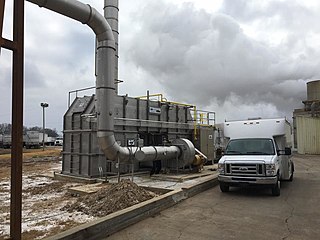
A fossil fuel is a fuel formed by natural processes, such as anaerobic decomposition of buried dead organisms, containing energy originating in ancient photosynthesis. The age of the organisms and their resulting fossil fuels is typically millions of years, and sometimes exceeds 650 million years. Fossil fuels contain high percentages of carbon and include petroleum, coal, and natural gas. Other commonly used derivatives include kerosene and propane. Fossil fuels range from volatile materials with low carbon to hydrogen ratios like methane, to liquids like petroleum, to nonvolatile materials composed of almost pure carbon, like anthracite coal. Methane can be found in hydrocarbon fields either alone, associated with oil, or in the form of methane clathrates.
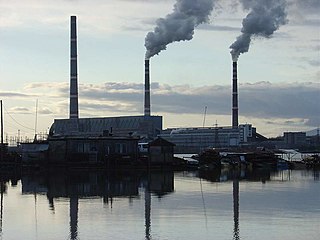
A carbon tax is a tax levied on the carbon content of fuels. It is a form of carbon pricing. Carbon is present in every hydrocarbon fuel and converted to carbon dioxide and other products when combusted. In contrast, non-combustion energy sources—wind, solar, geothermal, hydropower, and nuclear—do not convert hydrocarbons to CO
2.

A green vehicle, or clean vehicle, or eco-friendly vehicle or environmentally friendly vehicle is a road motor vehicle that produces less harmful impacts to the environment than comparable conventional internal combustion engine vehicles running on gasoline or diesel, or one that uses certain alternative fuels. Presently, in some countries the term is used for any vehicle complying or surpassing the more stringent European emission standards, or California's zero-emissions vehicle standards, or the low-carbon fuel standards enacted in several countries.
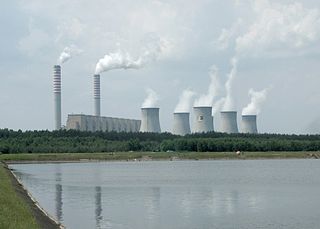
A fossil fuel power station is a thermal power station which burns a fossil fuel such as coal, natural gas, or petroleum to produce electricity. Central station fossil fuel power plants are designed on a large scale for continuous operation. In many countries, such plants provide most of the electrical energy used. Fossil fuel power stations have machinery to convert the heat energy of combustion into mechanical energy, which then operates an electrical generator. The prime mover may be a steam turbine, a gas turbine or, in small plants, a reciprocating internal combustion engine. All plants use the energy extracted from expanding gas, either steam or combustion gases. Although different energy conversion methods exist, all thermal power station conversion methods have efficiency limited by the Carnot efficiency and therefore produce waste heat.
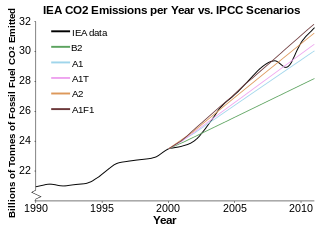
Climate change mitigation consists of actions to limit the magnitude or rate of long-term global warming and its related effects. Climate change mitigation generally involves reductions in human (anthropogenic) emissions of greenhouse gases (GHGs). Mitigation may also be achieved by increasing the capacity of carbon sinks, e.g., through reforestation. Mitigation policies can substantially reduce the risks associated with human-induced global warming.

Coal pollution mitigation, often called clean coal, is a series of systems and technologies that seek to mitigate the pollution and other environmental effects normally associated with the burning of coal, which is widely regarded as the dirtiest of the common fuels for industrial processes and power generation.

Biomass is plant or animal material used for energy production, heat production, or in various industrial processes as raw material for a range of products. It can be purposely grown energy crops, wood or forest residues, waste from food crops, horticulture, food processing, animal farming, or human waste from sewage plants.
Indoor air pollution in developing nations is a significant form of indoor air pollution (IAP) that is little known to those in the developed world.
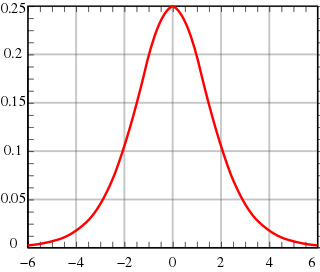
The mitigation of peak oil is the attempt to delay the date and minimize the social and economic effects of peak oil by reducing the consumption of and reliance on petroleum. By reducing petroleum consumption, mitigation efforts seek to favorably change the shape of the Hubbert curve, which is the graph of real oil production over time predicted by Hubbert peak theory. The peak of this curve is known as peak oil, and by changing the shape of the curve, the timing of the peak in oil production is affected. An analysis by the author of the Hirsch report showed that while the shape of the oil production curve can be affected by mitigation efforts, mitigation efforts are also affected by the shape of Hubbert curve.
Green nanotechnology refers to the use of nanotechnology to enhance the environmental sustainability of processes producing negative externalities. It also refers to the use of the products of nanotechnology to enhance sustainability. It includes making green nano-products and using nano-products in support of sustainability.
Bio-energy with carbon capture and storage (BECCS) is a potential greenhouse gas mitigation technology which produces negative carbon dioxide emissions by combining bioenergy (energy from biomass) use with geologic carbon capture and storage. The concept of BECCS is drawn from the integration of trees and crops, which extract carbon dioxide (CO2) from the atmosphere as they grow, the use of this biomass in processing industries or power plants, and the application of carbon capture and storage via CO2 injection into geological formations. There are other non-BECCS forms of carbon dioxide removal and storage that include technologies such as biochar, carbon dioxide air capture and biomass burial and enhanced weathering.
EuroNanoForum 2009 was the fourth conference in a set of European nanotechnology conferences organized within the framework of national presidencies and promoted by DG research, Directorate G.
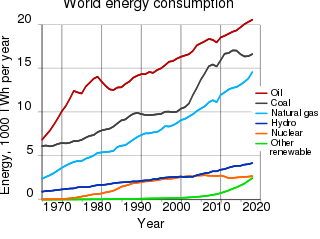
The environmental impact of the energy industry is diverse. Energy has been harnessed by human beings for millennia. Initially it was with the use of fire for light, heat, cooking and for safety, and its use can be traced back at least 1.9 million years. In recent years there has been a trend towards the increased commercialization of various renewable energy sources.

Petroleum is one of the main sources of energy in the World. Petroleum and its by-products are used to fuel various forms of transportation, industry and domestic electricity use. Petroleum is also used to manufacture plastics which provides products essential for daily life. Also, petroleum has helped create many products like cosmetics, tyres (rubber) pesticides etc. Over the years there have been increased concerns over the environmental effects of the petroleum industry. The environmental impacts of petroleum are mainly negative. This is due to the toxicity of petroleum which contributes to air pollution, acid rain, and various illnesses in humans. Petroleum also fuels climate change, due to the increased greenhouse gas emissions in its extraction, refinement, transport and consumption phases.
Abatement cost is the cost of reducing environmental negatives such as pollution. Marginal cost is an economic concept that measures the cost of an additional unit. The marginal abatement cost, in general, measures the cost of reducing one more unit of pollution.
Climate change scenarios or Socioeconomic scenarios are projections of future greenhouse gas (GHG) emissions used by analysts to assess future vulnerability to climate change. Producing scenarios requires estimates of future population levels, economic activity, the structure of governance, social values, and patterns of technological change. Economic and energy modelling can be used to analyse and quantify the effects of such drivers.

Carbon-neutral fuel is energy fuel or energy systems which have no net greenhouse gas emissions or carbon footprint. One class is synthetic fuel produced from renewable, sustainable or nuclear energy used to hydrogenate carbon dioxide directly captured from the air (DAC), recycled from power plant flue exhaust gas or derived from carbonic acid in seawater. Renewable energy sources include wind turbines, solar panels, and hydroelectric power stations. Another type of renewable energy source is biofuel. Such fuels are potentially carbon-neutral because they do not result in a net increase in atmospheric greenhouse gases.

Climate change has worsened at the hands of human activity for centuries, and many scientific efforts have been made since the first political acknowledgment. In order to avoid the ongoing and potential impacts of climate change, mitigation technologies have been developed in order to adapt to the issue, each invention belonging to one of four specific groups of effort. These groups include energy efficiency improvements, renewable energy (RE), nuclear power/energy (NE), and carbon capture storage (CCS). However, concerns regarding mitigating and adapting to climate change commonly have a priority focus on the groups of carbon capture storage and renewable energy efforts.


